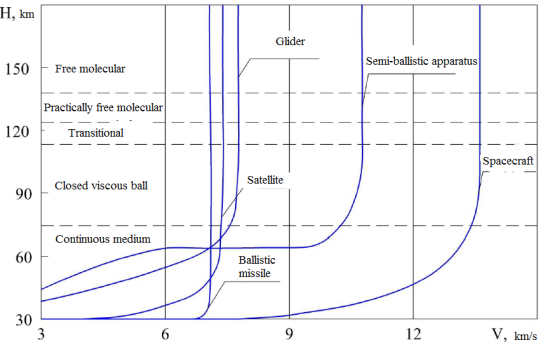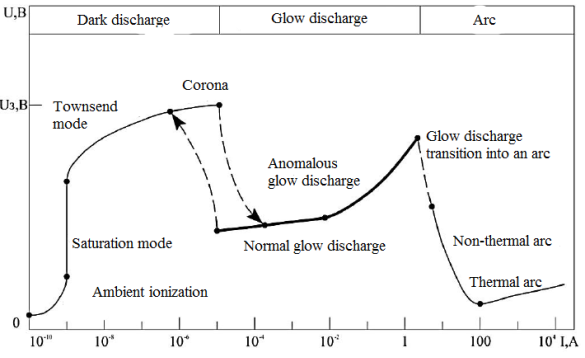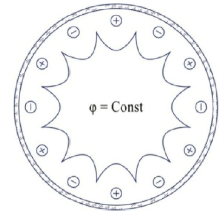The article is devoted to the consideration of advantages of low-temperature plasma formation for modern communication technologies. On the example of optimal conditions for low-temperature plasma formation intended to reduce the density of a stochastic ionized medium around a spacecraft (SC), it has been proved possible to create optimal conditions for interaction with a plasma high-temperature film, with the purpose of locally reducing its density.
Keywords: low-temperature plasma, spacecraft, ionized medium, film, density.
Modern development of scientific and technological progress puts the newest set of tasks for researchers to ensure rapid development of fundamental theoretical and experimental research in the field of plasma. Using plasma medium properties in communications is a promising direction of modern technology. Particular attention is paid to reliability of radio engineering devices operation in a mode that allows the use of plasma medium with stable parameters in various telecommunications devices and navigation systems [1].
The operation principle of modern satellite telecommunications (ST) is based on the use of satellite signal repeaters (SST), through which communication with ground stations is carried out. Individual communication stations can be located on the Earth’s surface, in the atmosphere, or in outer space. In each of these points there is a transceiver radio communication station. Existing methods for solving the problem of increasing the communication noise immunity are based, above all, on power amplification of SST input signals and their spectra transfer to other frequencies [2]. However, between some STs, very complex signal processing takes place in order to reduce crosstalk and increase the noise immunity of the system as a whole.
In order to ensure high-quality communication in the telecommunications system, the SSTs are located on several satellites in different orbits [3]. This approach significantly increases the cost of communication and significantly worsens the electromagnetic compatibility of radio systems, with relatively low reliability and quality of telemetry, which leads to reduction in its range in the event of the impact of external interference signals.
Detailed analysis of domestic and foreign scientists’ developments on this subject indicates that for today, the use of non-equilibrium plasma is promising for modern communication technologies. Individual scientific communities use the latter primarily in the gas phase. For this purpose, corona, barrier or spark plasma discharges are used. Contact non-equilibrium low-temperature plasma occupies a special place among plasma-chemical discharges. Plasma discharge is generated between the electrode which is in the gas phase and the surface of liquid in the volume of which the other electrode is located.
Thus, development and implementation of low-temperature plasma radiation sources with stable operational parameters for modern telecommunications and navigation facilities operating in a pulsed mode, opens practically inexhaustible possibilities for modern communication technologies.
Advantages of low-temperature plasma formation for modern communication technologies will be considered on the example of optimal conditions for the formation of low-temperature plasma to reduce the density of stochastic ionized medium around the spacecraft (SC).
High-temperature plasma medium creates a non-transmissive zone for electromagnetic oscillations of the radio range. As a result, there is no feedback from the SC and there are distortions or time delay of control commands which are sent to it. This leads to the SC safety decrease. Fig. 1 shows the modes of plasma flow around the SC during its launch into orbit.

Fig. 1 Modes of plasma flow during spacecraft launch into orbit
The newest method of increasing the satellite telecommunications noise immunity is the effect on external plasma environment for the purpose of plasma clearing. In this case, the most acceptable way of transferring information through plasma is based on simultaneous effect of an electron beam, an acoustic wave, and an information signal on plasma. The change in plasma properties is associated with a change in permittivity, which becomes greater than unity, and therefore it becomes possible to transmit a communication signal with a frequency lower than plasma frequency.
One of the most important interactions of the charge carrier with neutral particles is bulk ionization, which is necessary to maintain the steady state of plasma and electrical conductivity of the gas. The glow discharge is an independent electric discharge in a gas with cold plane-parallel electrodes with working gas pressure equal to (10–3–15) kPa and discharge current in the interval of (10–5–1) A, as shown in Fig. 2.

Fig. 2. Electric discharge in gases
Gas-discharge plasma is formed in the zones of positive column and negative radiation of glow discharge. Positive column plasma represents the largest ignited discharge region in the case of sufficiently large distance between anode and cathode.
The carried out research of a glow discharge showed that the most convenient form of coplanar discharge gap is encountered when the electrode system is located in one plane at one of the end faces of discharge chamber, and discharge areas occupy the entire volume [4]. The created complicated conditions act only directly in the gap between anode and cathode. This form of discharge gap is convenient for placement in the vicinity of the SC slot antenna. The end face of plasma facing the electrodes plane has a sharp radiation boundary, and the reverse end face is characterized by a low-contrast boundary of spherical shape.
Experimental studies of a coplanar discharge have shown that under complicated conditions anode and cathode can be brought together up to a very small distance and be united in one plane. On the basis of this, in the localized device rod anodes and cathodes are located on one cylindrical surface at a distance of 0,25l0, i.e.:
lp=0,2510p0
where p0 is a gas pressure, l0 is a distance between electrodes, which is necessary to place a normal short gloss discharge, when the pressure is equal to p0.
The proximity of rod anodes and cathodes in the case of creating complicated conditions is reflected in the nature of total electric field of localized discharge gap. An electrolytic bath was used to study the discharge gap shape. It was found out that in the central region of this gap the equipotential space without electrostatic field is localized (Fig. 3).

Fig. 3. Geometry of electrostatic field of a localized discharge gap: + rod anodes; — rod cathodes
In the course of studies it was found that the overall diameter of coplanar electrodes is 1.5 times larger than in a plane parallel discharge. Thus, plasma column diameter in coplanar discharge is the same number of times larger. The extension and intensity of plasma emission of coplanar discharge is substantially higher than that of the conventional one. Under the influence of fast electrons, which come from a dark space, elementary processes are formed only on one boundary of coplanar discharge plasma. As a result, artificially created plasma is characterized by unilateral ion and electron emission.
In a glow discharge with plane-parallel electrodes, the relaxation length of fast electrons in plasma is limited not only by inelastic processes impact, but also by a counter electric field of low strength [5]. This field is formed by space charge of electrons on the boundary with Faraday dark space. As a result of this, the counter electric field reduces relaxation length of the electron and the extension of high-temperature outer plasma.
In the coplanar discharge, fast electrons after their release into plasma decrease their relaxation length only under the influence of inelastic processes, since there is no counter electric field in their path, and there is no space charge of Faraday dark space and anode electrons. In this connection, fast electrons enter plasma not only through the surface opposite the cathode, but also through the surface of plasma that is located opposite the anode. Under the influence of increased processes of total emission of charge carriers, a substantially larger flux of positive ions to cathode is created, as well as a similarly large flux of electrons to anode.
So, summing up the results, we should note that prospective directions of using low-temperature plasma for modern communication technologies are considered on the example of decreasing the density of stochastic ionized medium around the SC. Generation of a low-temperature negative-radiation plasma around the SC antenna, which repels the ionized external flow of high-temperature plasma, makes it possible to create a radio-permeable medium. The low-temperature negative-radiation plasma has equipotential and quasi neutral characteristics. These characteristics form optimal conditions for interaction with plasma high-temperature film, with the purpose of local reduction of its density. As a result, stable “enlightened” windows are formed, which facilitate unimpeded transmission of radio signals of communication with the spacecraft.
References:
- Ablameiko S. V., Saechnikov V. A., Spiridonov A. A. Satellite communication systems: A manual for students of Radio Physics and Computer Technologies. — Minsk: BSU, 2012. — 147 p.
- Gavrilenko, V.G., Yashnov V. A. The propagation of electromagnetic waves in inhomogeneous plasma // Nizhny Novgorod: Nizhny Novgorod State University, 2015. — 101 p.
- Kurnaev, V. A. Plasma — XXI century. — М.: MEPhI, 2008. — 90 p.
- Kunitsyn, V.E., Tereshchenko E. D., Andreev E. S. Radio-tomography of the ionosphere. — М.: Physmathlit, 2007. — 345 p.
- Smirnov, B. M. Theory of Gas Discharge / B. M. Smirnov // Plasma Springer Series on Atomic, Optical, and Plasma Physics, Switzerland. — 2015. — P. 423.

